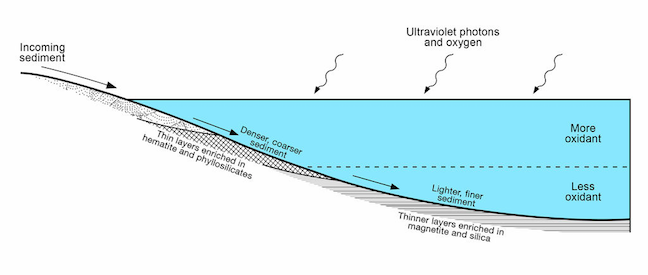This article is more than 1 year old
Curiosity rover's crater 'offered multiple microbe-friendly environments'
Chemical analysis of Gale Crater finds Martian lakes were a lot like ours
Mars' Gale Crater was once home to a body of water “that offered favorable conditions for microbial life” thanks to stratification that meant different parts of the lake offered different conditions.
That's the conclusion of a new paper, Redox stratification of an ancient lake in Gale crater, Mars, that examined data from the first three-and-a-half years of the Curiosity rover's trundlings around the red planet.
Published in Science and summarised by NASA, the paper explains that Curiosity has spotted different types of minerals that suggest the lake in Gale Crater had the composition depicted below.

A hypothesized redox-stratified lake in Gale crater. Source: Science via. mars.jpl.nasa.gov
"This type of oxidant stratification is a common feature of lakes on Earth, and now we've found it on Mars,” writes Joel Hurowitz of Stony Brook University, lead author of the report. “The diversity of environments in this Martian lake would have provided multiple opportunities for different types of microbes to survive, including those that thrive in oxidant-rich conditions, those that thrive in oxidant-poor conditions, and those that inhabit the interface between those settings."
NASA's summary of the paper says that as Curiosity moved around Gale Crater, astroboffins quickly concluded that rivers once flowed into the area. But they were confused by find of some rocks with “thicker layering with a larger proportion of an iron mineral called hematite, while other rocks showed very fine layers and more of an iron mineral called magnetite.”
"What was causing iron minerals to be one flavor in one part of the lake and another flavor in another part of the lake?” Hurowitz asked. “We had an 'Aha!' moment when we realized that the mineral information and the bedding-thickness information mapped perfectly onto each other in a way you would expect from a stratified lake with a chemical boundary between shallow water and deeper water.”
We've still no idea whether Mars ever hosted so much as a single microbe. But NASA is still chuffed with this paper, as it shows that Curiosity landed in a spot that offered a fine look at lots of different environments that together let us piece together Martian history. &Reg;
